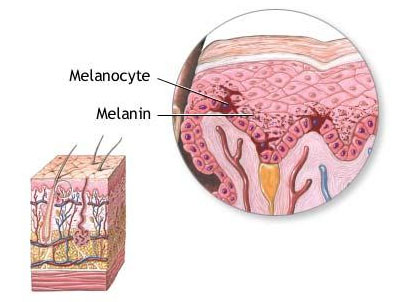Melanocyte
Editor-In-Chief: C. Michael Gibson, M.S., M.D. [1]
Overview

Melanocytes are cells located in the bottom layer (the stratum basale) of the skin's epidermis and in the middle layer of the eye (the uvea).
Melanogenesis
Through a process called melanogenesis, these cells produce melanin, which is a pigment found in the skin, eyes, and hair. This melanogenesis leads to a long lasting tan which is in contrast to the tan that originates from oxidation of already existing melanin.[1]
There are both basal and activated levels of melanogenesis; lighter-skinned people generally have low basal levels of melanogenesis. Exposure to UV-B radiation causes an increased melanogenesis due to the DNA photodamage that is generated by UV-B.[2]
Since the action spectrum of sunburn and melanogenesis are virtually identical, it is assumed that they are induced by the same mechanism.[3] The agreement of the action spectrum with the absorption spectrum of DNA points towards the formation of cyclobutane pyrimidine dimers (direct DNA damage). The acronym for cyclobutane pyrimidine dimers is CPD's.
Human differences
There are typically between 1000 and 2000 melanocytes per square millimeter of skin. Melanocytes comprise from 5% to 10% of the cells in the basal layer of epidermis. Although their size can vary, melanocytes are typically 7 micrometres in length.
The difference in skin color between fair people and dark people is due not to the number (quantity) of melanocytes in their skin, but to the melanocytes' level of activity.
Albinos lack an enzyme called tyrosinase. Tyrosinase is required for melanocytes to produce melanin from the amino acid tyrosine.
Embryology
Embryologically, melanocytes are derived from the neural crest, which is a completely different source than that of the surrounding skin cells (keratinocytes).
All melanocytes have the capacity to migrate widely in the embryo. Therefore, a cancer of a melanocyte (which is called a melanoma) will spread (metastasize) very easily. For this reason, melanomas are often fatal. When melanomas are surgically removed, much of the surrounding tissue must be taken as well.
Stimulation
Numerous stimuli are able to alter melanogenesis, or the production of melanin by cultured melanocytes, although the method by which it works is not fully understood. Vitamin D metabolites, retinoids, melanocyte-stimulating hormone (ie: Melanotan), forskolin, cholera toxin, isobutylmethylxanthine, diacylglycerol analogues, and UV irradiation all trigger melanogenesis and in turn, pigmentation.[4] The production of melanin is also initiated by ACTH (an adrenocorticotropic hormone).
Once made, melanin is moved along arm-like structures called dendrites in a special container called a melanosome which is shipped to the keratinocytes. Melanosomes are vesicles or packages of the chemical inside a plasma membrane. The melanin is in organelles called "melanosomes", that are organized as a cap protecting the nucleus of the keratinocyte.
When ultraviolet rays penetrate the skin and damage DNA; thymidine dinucleotide (pTpT) fragments from damaged DNA will trigger melanogenesis [5] and cause the melanocyte to produce melanosomes, which are then transferred by dendrite to the top layer of keratinocytes.
See also
- Chromatophore (the pigment cell type found in cold blooded animals)
- Eye color
- Melanoma
- tanning activator
References
- ↑ [tanning tips]
- ↑ Nita Agar; Antony R. Young (2005). "Review: Melanogenesis: a photoprotective response to DNA damage?". Mutation Research/Fundamental and Molecular Mechanisms of Mutagenesis. 571 (1–2): 121–132. PMID 10.1016/j.mrfmmm.2004.11.016 Check
|pmid=value (help). - ↑ John A. Parrish, Kurt F. Jaenicke, R. Rox Anderson (1982). "ERYTHEMA AND MELANOGENESIS ACTION SPECTRA OF NORMAL HUMAN SKIN". Photochemistry and Photobiology. 36 (2): 187–191. doi:10.1111/j.1751-1097.1982.tb04362.x.
- ↑ Ultraviolet B Radiation Acts through the Nitric Oxide and cGMP Signal Transduction Pathway to Stimulate Melanogenesis in Human Melanocytes - Roméro-Graillet et al. 271 (45): 28052 - Journal of Biological Chemistry
- ↑ Enhancement of DNA repair in human skin cells by t...[Proc Natl Acad Sci U S A. 1997] - PubMed Result
External links
- Ito S (2003). "The IFPCS presidential lecture: a chemist's view of melanogenesis". Pigment Cell Res. 16 (3): 230–6. PMID 12753395.
- Melanocytes at the US National Library of Medicine Medical Subject Headings (MeSH)
- Template:EMedicineDictionary
- Histology image: 07903loa – Histology Learning System at Boston University - "Eye: fovea, RPE"
- Histology image: 08103loa – Histology Learning System at Boston University - "Integument: pigmented skin"
de:Melanocyt el:Μελανοκύτταρο he:מלנוציט lv:Melanocīts lt:Melanocitas ml:മെലനോസൈറ്റുകള് nl:Melanocyt fi:Melanosyytti sv:Melanocyter